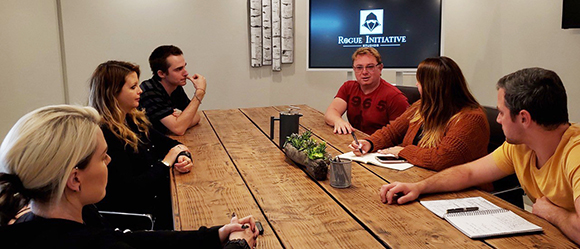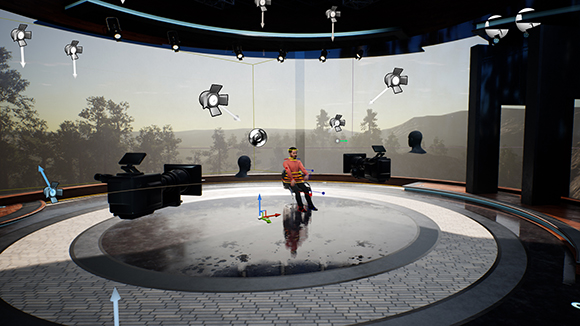Co-founder/chief of production and producer Cathy Twigg got her start finding new talent at MTV Films, before going on to hold executive positions in production, writing and worldwide distribution at Dreamworks Animation, Dreamworks Television Animation, Sony Pictures Television, NBC and Bandeira Entertainment.

Today, Rogue Initiative has teams in Los Angeles, UK, Beijing and Hong Kong. The headquarter studio is home to a growing cadre of artists, interactive designers and engineers. At press time, Rogue Initiative executives were further scouting for talent at Game Developers Conference (GDC) in San Francisco. In addition to their work on video games and high-end interactive simulations, Rogue Initiative recently extended their list of services by capitalizing on their expertise in game development and game engine technology. The studio now provides previs and virtual production services for feature films in partnership with Area of Effect (
aoefx.com), a realtime visualization studio founded with renowned filmmaker and visual effects supervisor Robert Legato. AoE are currently working on several high-profile projects, including collaborations with some of Hollywood’s leading filmmakers.
“Pete and I started Rogue Initiative on a mission to create original story-worlds with a deep lore and nuanced characters in collaboration with blockbuster filmmakers and veteran game talent,” Cathy Twigg explains.
“As producers across several mediums, we’re taking our decades of experience in deal making, film production, game development and realtime technology to build and co-own the properties we create, along with our gifted and diverse development teams,” adds Pete Blumel. “Hollywood talent can finally own and participate in what they write, direct and produce with our model and framework. It took years to get those kinds of agreements drawn up between major film studios, talent and financiers. There was no precedent, but we’re there now.”
Area of Effect, the partner studio handling previs and realtime filmmaking, leverages Rogue Initiative’s collective technical and artistic experience in triple-A video game development and immersive experiences.
“We’ve developed tools, techniques and advanced processes born and honed from big budget video game development,” notes Devin Ehrig, general manager of AoE. “We continue to refine our proprietary software to meet the ever-growing needs for realtime and virtual production services in feature film, TV and commercial work. This allows us — from the early stages, all the way through the entire production pipeline — to apply video game and realtime rendering technologies and best practices to our workflows.

“When people say ‘virtual production,’ a lot of times they immediately think of LED displays and hardware, which is great when you display while shooting,” Ehrig continues. “We also work with in-camera effects, but tend to dive deeper, towards previs, tech-vis, and now science-vis is an area we’re exploring, which is really quite fascinating. We understand that most of the excitement about virtual production comes from new facilities, but we believe the most impactful changes it brings to Hollywood happen before a single pixel lights up.”
The studio is working with several noteworthy filmmakers, including director Michael Bay (Armageddon, Pearl Harbor, 13 Hours, Ambulance and the Tranformers franchise) on a yet-to-be announced Sony Pictures/Columbia Pictures feature film, of which both Blumel and Twigg are producers, leveraging a unified virtual art department, all based on intellectual property developed through the partnership.
Rogue Initiative created initial environments, locations and big action sequences for previs with an eye toward assets for potential final pixel. The team has assembled a virtual film crew to collaborate remotely over a secure private network with Michael Bay blocking and directing while in a VR headset. His shots are then output from Unreal Engine and processed in post.
“At Rogue Initiative we love finding solutions to complex technical and creative tasks. Never tell a director he can’t have a shot,” states Blumel of the studio’s workflow, which involved both significant software engineering and interactive design using Unreal Engine, with the director in Florida and the Rogue Initiative/Area of Effect teams in Los Angeles. “This type of remote, iterative collaboration is the future of filmmaking and game development. Adjustments and follow-up shots are happening in realtime. A director can play with depth of field, move the camera and get a shot from any perspective in moments…[It’s a] very good use case for creating our ‘unified virtual art department’ and pipeline. It’s been my dream to build since my early days at Amblin.”
Blumel notes that in many cases, when they make the game-engine assets, they also make the movie and marketing assets too, and vice versa.
“We leverage existing work and production dollars. Plan ahead, iterate fast and keep the art optimized. I’ve done this with productions my entire career. It’s very exciting and fulfilling work."
Virtual cameraman and animator Maxwell Borsiczky works with both Rogue Initiative and Area of Effect, bringing his particular expertise with Unreal Engine to projects by helping to process and shoot animations being created by a global team of animators and 3D artists.
“Basically, I ensure animations from various artists all come together in Unreal Engine and achieve a cohesive look, and extremely high visual bar,” he says of his role. “Also, cutting out that render time and front loading a great deal of post work to previs is simply an amazing toolset. I operated as the guy taking all the animations we had and put them together. From there, I acted as the virtual camera assistant in Unreal Engine. Rogue Initiative and Area of Effect have a very efficient and nimble pipeline to get that amazing graphic quality and slick ‘handheld shot’ feeling out of Unreal that previs has often historically lacked.”
Render times, he notes, are almost instant when using the engine.
“You’re basically processing the shot as long as it takes to play it…If it’s a :10 shot, it takes about :10 to render out.”
Joseph Howard is a Rogue Initiative engineer, and was heavily involved in coding production specific tools and managing all the remote filming sessions.
“I would log in and join the actual film session, and make sure we’re all connected securely on our network, and that all the camera and dailies export features that I built were working as intended,” Howard explains. “If any issues arose, I was on-set to make changes on the fly — adjust some blueprints or go back and write some custom code at light speed.”
Howard would also process the shot outputs, formatting them for distribution to editorial.
Associate producer Bryce Cohen has experience working with Legato, having collaborated with the VFX supervisor on an upcoming film from producer/director Antoine Fuqua.
“I can’t imagine a better way to work in this day and age,” says Cohen of the remote workflow. “Rob would give us a call from location. We could share screens with him instantaneously and he’d show me the issue that he was having. In one case, he wanted to have a character move from point A to point B, but the character’s feet weren’t staying on the ground…I’d diagnose the issue and say, ‘Yeah, we understand. Hang tight. We’ll be right back to push a fix to you.’ At the studio, we have a ‘quick reaction team’ at the ready for exactly these types of situations. This team maintains hardware and software parity with key remote HP workstations on our various productions. I rallied a senior designer, an engineer, and we immediately got to work on the solution. Meanwhile, Rob could work on his next shot, take a meeting or grab a cup of coffee. When he’s back, the fixes are installed and ready for him to resume work on the shot. (He) can continue being creative while we troubleshoot technical issues offsite.”
Rogue Initiative and AoE’s technical infrastructure is based on a group of Z by HP workstations, all identically equipped.
“It’s actually a clever process that’s saved us time and money on several occasions,” says Blumel in reference of HP’s hardware and software parity across his organization. “We don’t want a filmmaker to come in one morning and see a message, ‘Oh, there’s an update to some firmware.’ Or to Windows, or an issue updating the latest version of the project from Perforce…No. We ensure that whatever issues arise, happen to us in the test lab first before it happens on a production computer. In our workflow, we’ll have already seen it. We apply a proven, tested solution, then we remote in and adjust the production computers before anything ever arises that could stall the filmmakers.”
“It’s like having a creative technology strike team and hardware stack that enables DPs, cinematographers and directors to easily use the tech,” adds Ehrig. “That synchronicity and shorthand language between tech and creative, that kind communication allows the magic to happen.”
“This is part of what makes us extremely unique”, adds Twigg, “Our production experience in film, games and animation, along with realtime engines ensures that we understand and foresee the needs of all the stakeholders on a production from story to tech so that nothing is compromised.”
The Rogue Initiative and Area of Effect teams are as much about coming up with creative technical solutions as they are about managing the merger of different viewpoints from film, realtime production and game development. Through communication, experience and expertise, they’re able to unite often at-odds perspectives.
Blumel says, “Though intersecting tech and storytelling are key to our business, it often comes down to producing. The subtle art of bringing together immensely talented creative storytellers with pioneer technology, triple-A game development practices, and the most sophisticated computer hardware in the industry will empower filmmakers in forging this exciting new paradigm.”